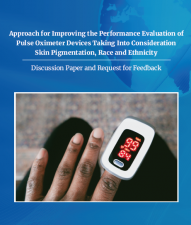Pulse Oximeters
A pulse oximeter (or pulse ox) is a device that is usually placed on a fingertip and uses light beams to estimate the oxygen saturation of the blood and the pulse rate. Oxygen saturation gives information about the amount of oxygen carried in a person’s blood. A pulse oximeter can estimate the amount of oxygen in the blood without having to draw a blood sample.
On this page:
Use of Pulse Oximeters
If you are using a pulse oximeter to monitor your oxygen levels at home and are concerned about the reading, contact a health care provider. Do not rely only on a pulse oximeter. It also is important to keep track of your symptoms or how you feel. Contact a health care provider if your symptoms are serious or get worse.
FDA Efforts Concerning Pulse Oximeters
The FDA has taken a number of steps to learn more about the safety and effectiveness of pulse oximeters, including looking at concerns about whether the accuracy of pulse oximeters is affected by a person’s skin pigmentation.
January 2025 – Draft Guidance
On January 7, 2025, the FDA issued the draft guidance: Pulse Oximeters for Medical Purposes: Non-Clinical and Clinical Performance Testing, Labeling, and Premarket Submission Recommendations.
The guidance, once finalized, will provide recommendations regarding non-clinical and clinical performance testing, and labeling of pulse oximeters that are used for medical purposes. This includes providing recommendations that:
- Inform how pulse oximeters are tested and evaluated to support premarket submissions.
- Make sure device labeling, including instructions, helps to promote the safe and effective use of pulse oximeters and helps people understand the benefits and risks of using them.
- Promote consistency and facilitate efficient review of premarket submissions for pulse oximeters.
Your feedback on the draft guidance is welcome. Submit comments under docket number FDA-2023-N-4976 at www.regulations.gov within 60 days of the draft guidance publication to ensure the FDA considers comments on this draft guidance before it begins work on the final version of the guidance.
When finalized, this guidance will supersede the 2013 guidance document: Pulse Oximeters - Premarket Notification Submissions [510(k)s]: Guidance for Industry and Food and Drug Administration Staff
Previous FDA efforts concerning pulse oximeters include the following:
The FDA held a virtual meeting of the CDRH Anesthesiology and Respiratory Therapy Devices Panel of the Medical Devices Advisory Committee on February 2, 2024 . The committee discussed pulse oximeters, including:
- An approach to improve the quality of premarket studies and associated methods used to evaluate the performance of pulse oximeters submitted for premarket review, taking into consideration a patient’s skin pigmentation, and patient-reported race and ethnicity.
- The type and amount of data that should be provided by manufacturers for the FDA to evaluate the performance of pulse oximeters submitted for premarket review, including prescription and over-the-counter indications, and labeling considerations.
- Ongoing concerns that pulse oximeters may be less accurate in individuals with darker skin pigmentation.
On November 16, 2023, the FDA published a discussion paper, Approach for Improving the Performance Evaluation of Pulse Oximeter Devices Taking Into Consideration Skin Pigmentation, Race and Ethnicity. The discussion paper offered an approach to improve the quality of premarket studies and associated methods used to evaluate the performance of pulse oximeters, taking into consideration patient skin pigmentation and patient-reported race and ethnicity.
The FDA invited feedback from interested parties and the public on a series of questions related to the approach. The comment period closed on January 16, 2024.
On November 1, 2022, the FDA convened a virtual public meeting of the CDRH Anesthesiology and Respiratory Therapy Devices Panel of the Medical Devices Advisory Committee to share information and perspectives from interested parties about ongoing concerns that pulse oximeters may be less accurate in individuals with darker skin pigmentations.
In May and August 2022, the FDA partnered with academic institutions to undertake two FDA-funded real-world evidence studies to evaluate the performance of pulse oximeters in adults and pediatric patients using simultaneous oximetry measurements and objective skin pigmentation measurement. This work aims to address limitations of existing published real-world studies.
The FDA issued a safety communication in 2021 informing patients and health care providers that although pulse oximetry is useful for estimating blood oxygen levels, pulse oximeters have limitations and a risk of inaccuracy under certain circumstances that should be considered. Multiple factors can affect the accuracy of a pulse oximeter reading, such as poor circulation, skin pigmentation, skin thickness, skin temperature, current tobacco use, and use of fingernail polish.
The FDA will keep the public informed if significant new information becomes available.


